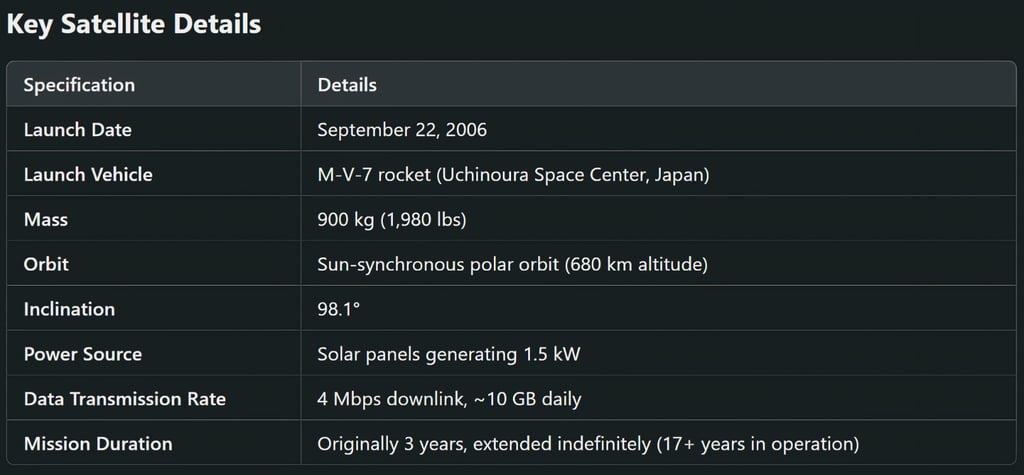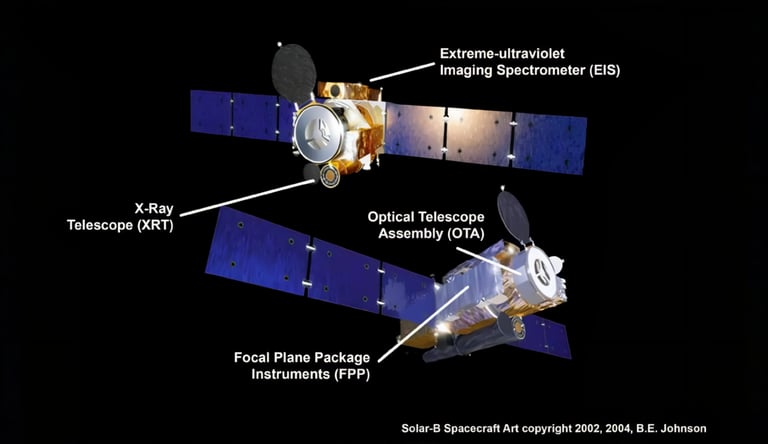
Hinode (Satellite): A Revolutionary Mission in Solar Physics
Hinode (Solar-B) is a groundbreaking solar observation satellite launched by JAXA in 2006. Discover its mission, instruments, key discoveries, and contributions to solar physics and space weather forecasting
SPACE MISSIONISRO/NASAEDUCATION/KNOWLEDGESPACE/TECH
Sachin K Chaurasiya
3/27/20254 min read


The Hinode satellite, formerly known as Solar-B, is a solar observation spacecraft launched by the Japan Aerospace Exploration Agency (JAXA) on September 22, 2006. It was developed in collaboration with NASA, the European Space Agency (ESA), and the UK Space Agency (UKSA).
Hinode’s mission is to study the Sun’s magnetic field, solar atmosphere, and dynamic processes that drive solar activity, including solar flares and coronal mass ejections (CMEs). With its state-of-the-art scientific instruments, Hinode provides uninterrupted, high-resolution data, significantly advancing our understanding of solar physics and space weather.
Mission Objectives: The Sun’s Dynamic Nature
Hinode aims to answer fundamental questions about the Sun’s behavior, focusing on:
The Sun’s Magnetic Field and Energy Transport
Investigate how magnetic fields emerge, evolve, and dissipate on the Sun’s surface.
Study the formation of sunspots, active regions and solar prominences.
Solar Atmosphere Heating and Dynamics
Explore why the Sun’s corona is much hotter than its surface (millions of degrees Kelvin vs. ~5,500°C).
Analyze how energy is transferred through the chromosphere and transition region into the corona.
Solar Flares and Coronal Mass Ejections (CMEs)
Identify the triggers of solar flares and their impact on space weather.
Track the behavior of CMEs that can disrupt Earth’s satellites, power grids, and communication systems.
Solar Wind Acceleration
Understand how the solar wind—a continuous stream of charged particles—is generated and accelerated.
Provide insights into the interaction between the Sun’s magnetic field and interplanetary space.
Hinode's observations help scientists predict space weather events, protecting spacecraft, astronauts, and Earth-based technology.
Technical Specifications of Hinode
Hinode is designed for continuous solar observation, operating in a Sun-synchronous polar orbit that allows it to observe the Sun without interruptions.


Scientific Instruments and Their Capabilities
Hinode is equipped with three primary instruments, each designed to study different layers of the Sun’s atmosphere and magnetic field.
Solar Optical Telescope (SOT)
The first space-based telescope capable of imaging the Sun’s magnetic field at high resolution.
It resolves solar features as small as 150 km—a major improvement over ground-based observations.
Observes the Sun in visible light to track sunspots, magnetic field lines, and convection patterns.
Uses the Narrowband Filter Imager (NFI) and Spectropolarimeter (SP) to measure the vector magnetic field of the Sun’s surface.
X-ray Telescope (XRT)
Captures images of the Sun’s corona in high-energy X-rays.
Can detect solar plasma at temperatures exceeding 10 million Kelvin.
Helps identify the formation and evolution of solar flares, coronal loops, and active regions.
Works in conjunction with NASA’s RHESSI (Reuven Ramaty High Energy Solar Spectroscopic Imager) to analyze high-energy solar emissions.
Extreme Ultraviolet Imaging Spectrometer (EIS)
Measures the speed, temperature, and density of plasma in the transition region and corona.
Observes the Sun’s extreme ultraviolet (EUV) emissions, tracking how energy moves through different layers of the atmosphere.
Detects fast-moving solar wind streams and regions where magnetic reconnection occurs.
These instruments allow Hinode to provide a multi-wavelength view of the Sun, revealing the connection between magnetic fields and solar activity.


Major Scientific Discoveries and Contributions
Hinode has made several groundbreaking discoveries in solar physics:
The Corona’s Mysterious Heating Mechanism
Confirmed that magnetic waves (Alfvén waves) play a key role in heating the corona.
Provided direct observations of energy transfer from the Sun’s surface to its outer atmosphere.
Magnetic Field Twisting and Solar Flares
Captured high-resolution images of sunspot magnetic fields before and after solar flares.
Showed that magnetic field lines twist, reconnect, and release energy, causing solar eruptions.
Role of Nanoflares in Heating the Corona
Detected small-scale magnetic explosions called nanoflares that may contribute to coronal heating.
Provided evidence that these miniature solar eruptions release energy throughout the solar atmosphere.
Mapping the Sources of the Solar Wind
Identified where and how solar wind originates from the Sun’s chromosphere and coronal holes.
Observed plasma jets and magnetic reconnection events, explaining variations in solar wind speed.
Understanding Sunspot Magnetic Fields
Created detailed maps of sunspot structure, revealing how magnetic field lines evolve over time.
Improved space weather forecasting by tracking magnetic changes that lead to solar storms.
Hinode’s data is crucial for predicting space weather and understanding the sun’s long-term solar cycle.
Hinode’s Role in Space Weather Prediction
Hinode’s real-time solar monitoring is essential for space weather forecasting, which protects:
Satellites and GPS systems from solar radiation.
Astronauts from high-energy cosmic rays.
Power grids and communication networks from geomagnetic storms.
By tracking solar flares and CMEs, Hinode helps organizations like NASA and NOAA issue early warnings to mitigate space weather effects.
Hinode vs. Other Solar Missions
Hinode works alongside other major solar missions, complementing their capabilities:


A Mission That Still Shines
Hinode has been a game-changer in solar physics, providing high-resolution images and data that have reshaped our understanding of the Sun. Even after 17+ years in orbit, it continues to deliver valuable insights into magnetic fields, solar flares, and coronal heating.
As we prepare for upcoming solar cycles, Hinode’s legacy will live on, helping scientists predict solar activity and protect our technology-dependent world. 🌞🚀
FAQs
What makes Hinode unique?
Its ability to continuously observe the Sun’s magnetic field and atmosphere at high resolution sets it apart from other solar missions.
How does Hinode contribute to space weather forecasting?
By tracking solar flares, CMEs, and solar wind sources, it helps predict disruptions to satellites, power grids, and communication systems.
Is Hinode still operational?
Yes! Originally planned for 3 years, it has surpassed 17 years and remains active.
Subscribe To Our Newsletter
All © Copyright reserved by Accessible-Learning Hub
| Terms & Conditions
Knowledge is power. Learn with Us. 📚


